Astilleros Gondan of Spain announced on 10th August that it had signed a contract to build a new fast ferry over a 9-month period that is claimed to be the fastest GRP passenger catamaran built in Spain. The vessel, which will reach 34 knots when fully loaded powered by two 3,000hp engines, that will also make it the most powerful GRP ferry built in Spain.
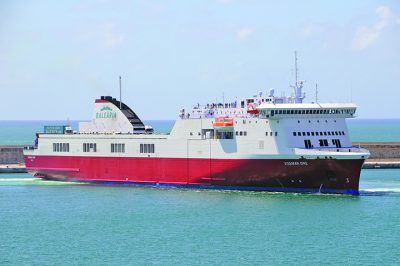
Baleària of Spain has purchased the 26,375gt/2010 built Ro-Pax ferry Visemar One, (above) which has been part of the company’s fleet for seven years. Baleària has invested around €55 million into purchasing the 8,702dwt ship. This acquisition brings the number of ships owned by Baleària to 26. The Visemar One was introduced by the company on the Barcelona-Palma route in 2011 and currently operates between València and Palma. The 186.4m long/ 25.6m beam ship can accommodate 600 passengers, 2,860 lanemetres of freight and 74 cars. Baleària also launched a new Tanger Med-Malaga Ro-Pax and freight service on 4th August.
Bornholmslinjen replaced Bornholmer-færgen on 1st September when Færgen’s contract for the Bornholm ferry service ceased. Long standing operator Molslinjen won the tender for the service with ferries sailing under the operating name of Bornholmslinjen. The new 18,009gt/2018 built Ro-Pax vessel Hammershus arrived in Køge, Denmark on 24th August and made her debut at Rønne on 31st August. Meanwhile the outgoing Bornholm operator, Færgen, has now sold the 6,402gt/2000 built highspeed vessel Villum Clausen to Greek operator SeaJets. MolsLinjen’s 10,504gt/2009 built Express 1 moved to the Bornholmslinjen service from 1st September.
Caledonian MacBrayne’s awaited newbuilds are running into problems long before they are even completed. The ships are destined for the Uig-Lochmaddy-Tarbert Triangle and Arran-Ardrossan. Ferguson Marine won the Scottish government contract (worth around £97 million) to build the vessels but has advised CalMac’s parent company, Caledonian Maritime Assets Ltd, of new delays.
The first ferry, the Glen Sannox, which is destined for the Arran-Ardrossan route, was launched in November 2017 and was due to enter service this summer. However, construction delays have meant that the date was deferred to the winter of 2018/19. Ferguson Marine then confirmed in August that the ship will not be ready until summer 2019, a full year behind schedule.
The second vessel, known as Hull 802, is earmarked for the Uig triangle but she is now not expected to be delivered until 2020. The Scottish Government gave a £30 million loan in June to the shipyard, which is owned by Jim McColl, a multimillionaire and a member of Nicola Sturgeon’s council of economic advisers, to aid cashflow during the building process. Not only will the ships be around 18 months late when they are delivered, but CalMac will then need two months of sea trials and crew training before the ferries can be put into service. To add insult to injury, capacity on both ships is expected to be reduced from the estimated 1,000 passengers due to design and disabled access requirements. The Scottish Government has also awarded CalMac a £3.5 million fund to assist in maintaining its fleet in the hope of limiting mechanical failures and any ensuing disruption.
Talking of which, on 8th August the 8,680gt/2014 built Loch Seaforth suffered a three-hour emergency with 343 passengers aboard when both main engines failed one after the other, reportedly due to coolant issues. Propulsion was eventually restored to one propeller to achieve “return to port mode” and the vessel made steady progress at 12 knots to Stornoway where repairs were completed.
Seatruck’s 7,606gt/1998 built Clipper Ranger was replaced on the Dublin-Liverpool route in September by the 14,759gt/2009 built Clipper Pennant whilst her 7,606gt/1998 built sister Arrow arrived at Larne for layover whilst on IoMSPCo. standby duties on 5th September.
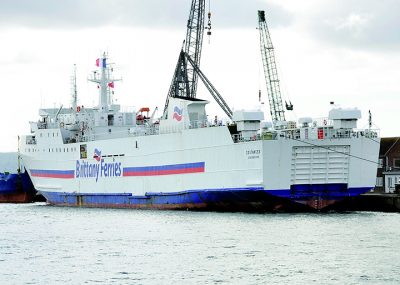

Conferry’s 6,507gt/1978 built Rosa Eugenia, formerly Brittany Ferries’ Coutances (above), sank at her moorings at Puerto la Cruz, Venezuela, in early September having been abandoned for two years. She is the third of the company’s vessels to sink, the others being the Carmen Ernestina in October 2016 and the Tallink Autoexpress 2 in August 2018.
Labrador Marine Services of Canada has reportedly purchased the 5,233gt/2010 built Muhamaa, the double-ended ferry that most recently operated as the Grete between Cuxhaven and Brunsbüttel across the River Elbe. It also seems likely that her sisters Saaremaa (5,233gt/2010) and Hiiumaa (5,233gt/2011) are also destined for the same Buyer. Such ice-strengthened vessels were being sought so as to increase the number of vehicles and passengers that could be conveyed on a service between St. Barbe, Newfoundland and Blanc Sablon, Quebec. The vessel or vessels should go to Fiskerstrand Verft AS first for modifications with the Muhamaa expected to replace the 6,480gt/1970 built Papenburg Sister, the Apollo
Seabourn Freight has launched its website for the proposed new ferry service between Ramsgate and Ostend. When the operation will start and which ships will be employed is still unknown.
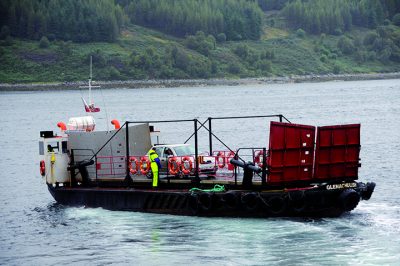
The Glenelg Ferry, Glenachulish (above), the world’s last sea-going, manually-operated turntable ferry has gained its first female Skipper in the shape of 21-year-old Isabelle Law. Isabelle worked on the Glenachulish as a summer job until training to take charge of the near 50-year-old ferry. The vessel serves the oldest crossing to Skye from the mainland across the Kylerhea Straits between Glenelg and Kylerhea on Skye. A car ferry service has operated there since 1934. The current service has been run by a community-owned company since 2007.
Stena Line has replaced the 10,572gt/1997 built Ro-Ro Bore Bay with the 20,381gt/1982 built Vikingland on the Gdynia-Nynäshamn freight route. The Bore Bay has since operated on the Harwich-Rotterdam Europoort service with the 13,017gt/1996 built Stena Scotia and the 24,688gt/2003 built Stena Forerunner moving to Irish Sea routes. The 13,017gt/1996 built Stena Hibernia and sistership Stena Scotia began operating together on the Belfast-Heysham on 22nd August with the former being dry docked at Harland & Wolff first.
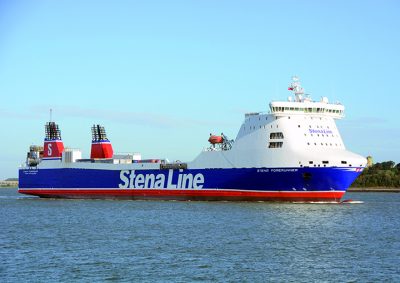
The Stena Forerunner (above) has replaced the 19,722gt/2012 built Stena Precision on the Belfast-Birkenhead route since 27th August with Seatruck taking both her and sister Stena Performer back for their Heysham-Warrenpoint operation. The latter emerged from dry dock at Cammell-Laird, Birkenhead, under her previous identity of Seatruck Performance on 28th August. Stena Line has also extended the contracts for the Godby Shipping owned Ro-Ro vessels Misana and Misida (15,586gt/built 2007) until December 2019. The ships operate on the Rotterdam-Killingholme and Rotterdam-Harwich services. On 4th September the 14,551gt/2005 built Hammerodde changed from a Færgen ship to a Stena Line one. The flag registry changed from Danish to Swedish and the new name will be Stena Vinga. The ship will join the Gothenburg-Frederikshavn route in mid-September following refit at the Öresundsvarvet Shipyard in Landskrona. As one ship enters the fleet, two others depart in the form of the 21,171gt/2004 built Stena Carrier and 21,104gt/2004 built Stena Freighter. The ‘Carrier has been renamed Mexico Star and reflagged to Mexico following her acquisition by Baja Ferries. The ‘Freighter’s Buyer was not known.
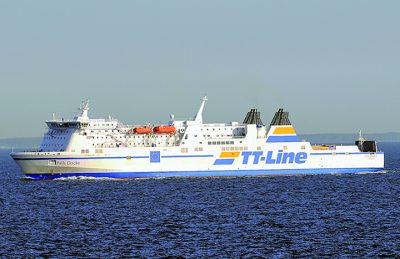
TT-Line has refurbished two members of the Ro-Pax ferry fleet, the 26,796gt/1995 built Nils Dacke (above) and 26,790gt/1995 built Robin Hood. The latter was completed at the end of July by the Oresund Drydock shipyard in Landskrona, Sweden.

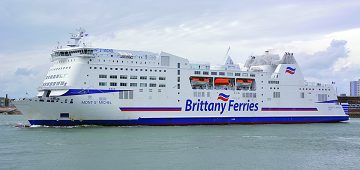



Comments
Sorry, comments are closed for this item